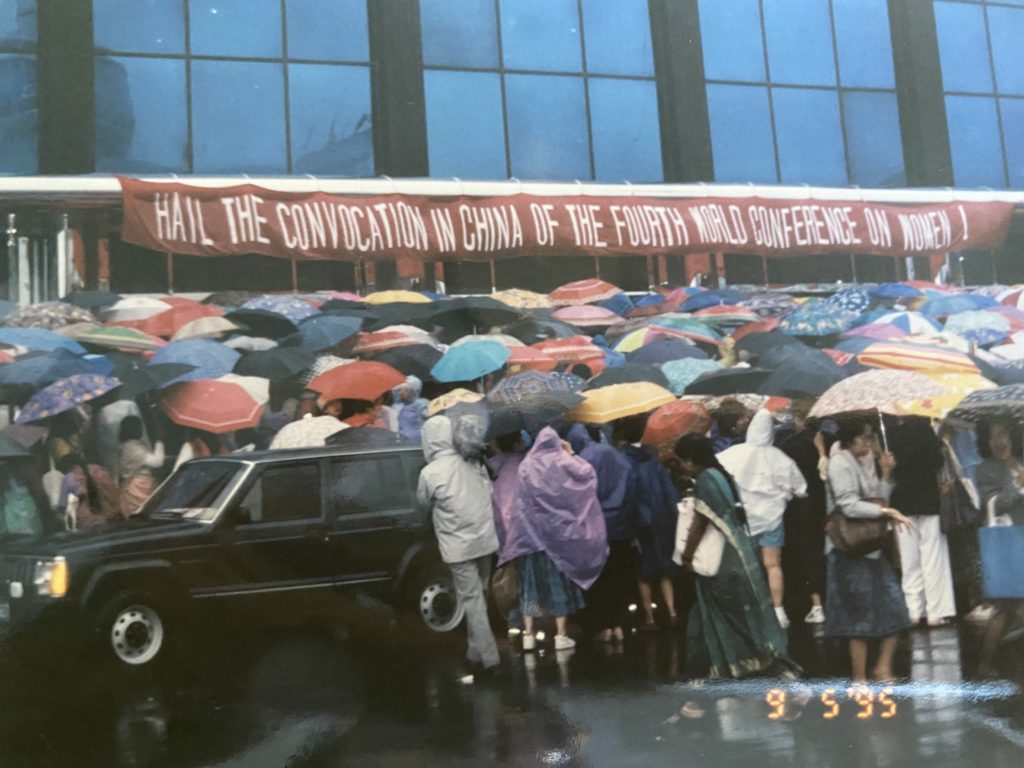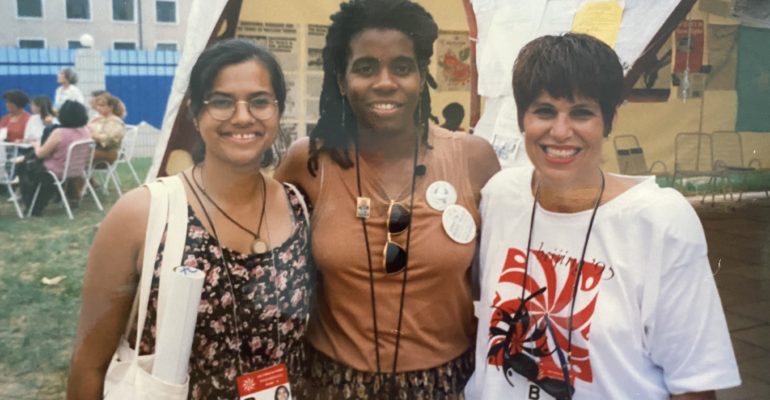Written by Past International President Patsy Daniels and Dawn Marie Lemonds.
In 1995, 189 Member States of the United Nations (UN) came to Beijing for the 10-day Fourth World Conference on Women (4WCW) to ratify the Beijing Platform for Action (BPfA), which was to become the blueprint for women’s equality around the world.

This historic event was the culmination of decades of work by governments and Non-Governmental Organisations (NGOs), working together to ensure women’s inclusion in every aspect of government and society.

Members of Soroptimist International stood together as part of the NGO community, participating every step of the way to ensure that issues important to women and girls were included in the Beijing Platform for Action (BPfA).

There were some significant documents/events that led to this final conference held in 1995:
1948:
Following World War II, the world came together to form a world organisation, the United Nations, in a great effort to work together toward the common good of All Nations and their people. The most important document framing the work of the United Nations was the ‘Universal Declaration of Human Rights’, and two articles set the stage for the world to embrace the equality of women and all human beings.
Article I: “All human beings are born free and equal in dignity and rights.”
Article II: “Everyone is entitled to all the rights and freedoms set forth in this Declaration, without distinction of any kind, such as race, colour, sex, language, religion, birth or other status.”
1948-1975:
Although “all human beings” were mentioned as equal it was clear that women were not fully included. Activists, NGOs, and some countries took up the challenge of women’s issues, presenting inequities in every area of society. This prompted the UN to acknowledge the year of 1975 and to declare International Women’s Year, which launched the decade of women from 1975-1985.
1975:
The First World Conference on Women was held in Mexico City and representatives of 133 countries and 6,000 NGO participants were in attendance for the launch of International Women’s Year. This conference produced a comprehensive set of guidelines to take the world through to 1985.
1979:
The Convention on the Elimination of all Forms of Discrimination against Women (CEDAW). Following the meeting in Mexico City, the UN General Assembly passed the Convention on the Elimination of all Forms of Discrimination against Women (CEDAW), and urged member states to ratify this important document. To date 187 countries have ratified. Notably, the United States is amongst seven countries who have not, together with the Pacific Island nations of Tonga and Palua, Iran, Somalia, South Sudan and Sudan.
1980:
The Second World Conference on Women was held in Copenhagen, and 45 Member States were present. Progress was reviewed on the goals previously identified at the First World Conference, and there were calls for Member States to design stronger measures regarding employment, health, and education.
1985:
The Third World Conference on Women took place in Nairobi, Kenya. Its mandate was to establish concrete measures to overcome obstacles facing women in the world. 157 Member States attended. A parallel NGO Forum was also held with 12,000 attendees, addressing pressing conditions affecting women world-wide. Plans were furthered to create a final global document with topics identified from previous conferences. This document would be the foundation for the final convention in 1995.
Between 1985 and 1995, people around the world attended committee meetings, collaborative groups, preparatory conferences all with the aim of ensuring that the final document embraced the most important issues for women. Surprisingly, it was not until 1994, that the issue of the Girl Child was added to the document following huge pressure from the NGO community. It subsequently became the final Chapter of 12 in the Beijing Platform for Action.
1995:
Following years of study, UN Member States, UN related organisations, NGOs, and women’s groups of all representations, lobbied for what the plan would say in the final document created for the Fourth World Conference on Women (4WCW). Over 35,000 people attended the a preceding parallel conference, with a further 15,000 people attending the 4WCW. 189 Member States were part of this important 10-day event which resulted in the Beijing Platform for Action (BPFA).

Here are the 12 Critical Areas:
- Women and Poverty
- Education and Training of Women
- Women and Health
- Violence against Women
- Women and Armed Conflict
- Women and the economy
- Women in power and decision making
- Institutional mechanisms
- Human Rights of women
- Women and the media
- Women and the environment
- The Girl Child

All of these issues remain important and relevant today, and have largely been included in the UN Sustainable Development Goals (SDGs), with the preamble to these goals affirming the importance of gender being a part of every goal and strategy conducted by the Member States.

For further information, please visit www.un.org and www.unwomen.org


Thanks so much Dawn Marie and Patsy. This was a great summary of the Fourth World Conference. My mom, Dr. Joan Cromer, past International President of Soroptimist, is in your sixth picture. She would be about my age now. I was so sorry that I didn’t go but it was shortly after my daughter Joanne was born (she is a proud 3rd generation Soroptimist now).